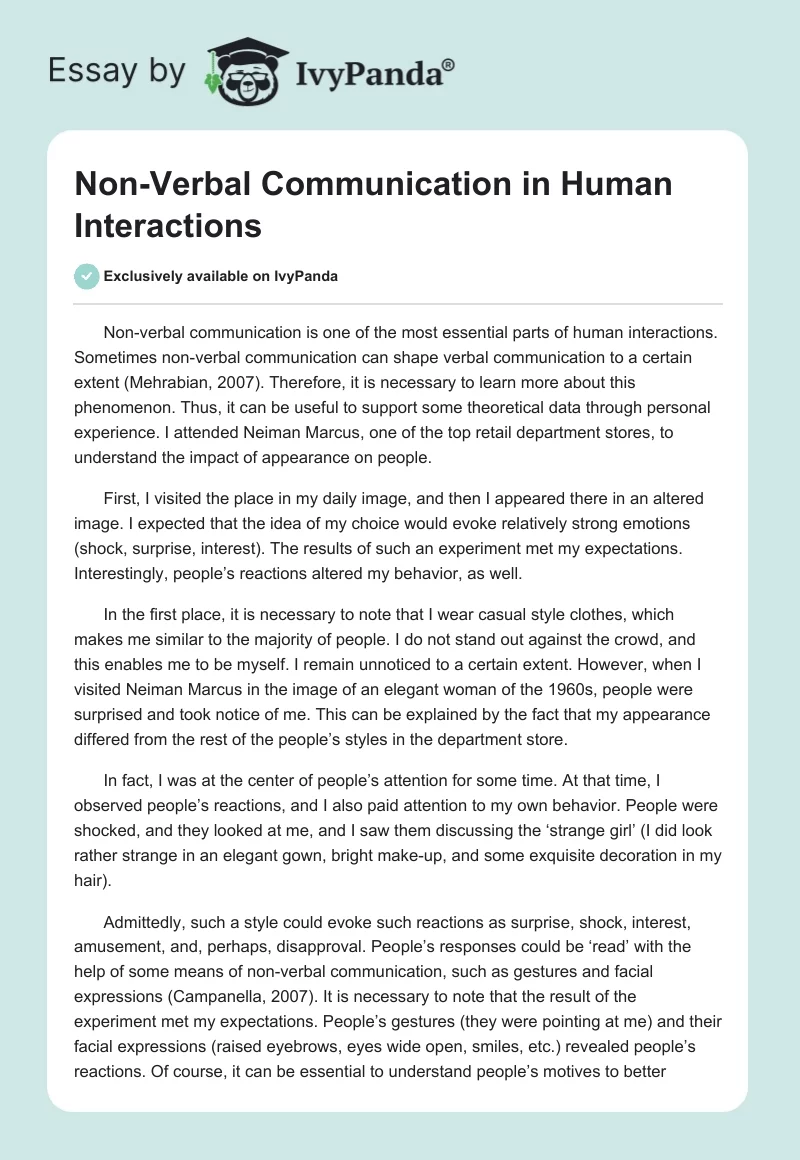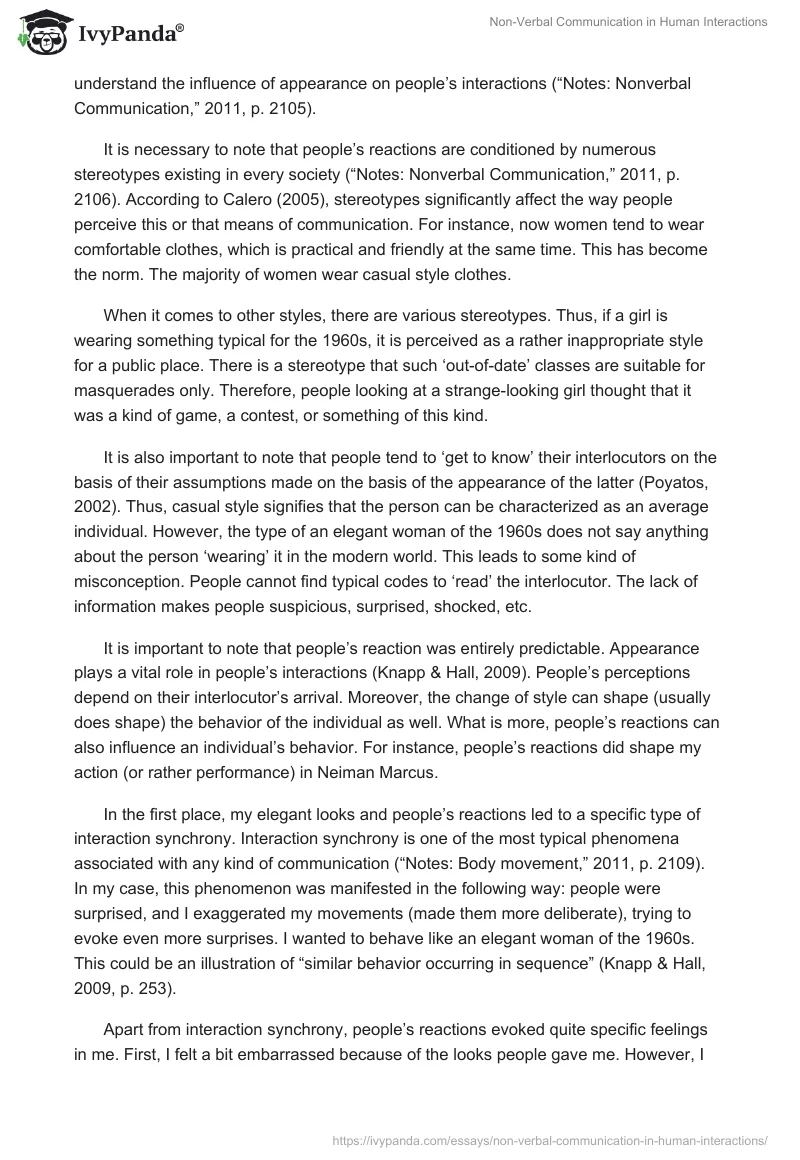Non-verbal communication is one of the most essential parts of human interactions. Sometimes non-verbal communication can shape verbal communication to a certain extent (Mehrabian, 2007). Therefore, it is necessary to learn more about this phenomenon. Thus, it can be useful to support some theoretical data through personal experience. I attended Neiman Marcus, one of the top retail department stores, to understand the impact of appearance on people.
First, I visited the place in my daily image, and then I appeared there in an altered image. I expected that the idea of my choice would evoke relatively strong emotions (shock, surprise, interest). The results of such an experiment met my expectations. Interestingly, people’s reactions altered my behavior, as well.
In the first place, it is necessary to note that I wear casual style clothes, which makes me similar to the majority of people. I do not stand out against the crowd, and this enables me to be myself. I remain unnoticed to a certain extent. However, when I visited Neiman Marcus in the image of an elegant woman of the 1960s, people were surprised and took notice of me. This can be explained by the fact that my appearance differed from the rest of the people’s styles in the department store.
In fact, I was at the center of people’s attention for some time. At that time, I observed people’s reactions, and I also paid attention to my own behavior. People were shocked, and they looked at me, and I saw them discussing the ‘strange girl’ (I did look rather strange in an elegant gown, bright make-up, and some exquisite decoration in my hair).
Admittedly, such a style could evoke such reactions as surprise, shock, interest, amusement, and, perhaps, disapproval. People’s responses could be ‘read’ with the help of some means of non-verbal communication, such as gestures and facial expressions (Campanella, 2007). It is necessary to note that the result of the experiment met my expectations. People’s gestures (they were pointing at me) and their facial expressions (raised eyebrows, eyes wide open, smiles, etc.) revealed people’s reactions. Of course, it can be essential to understand people’s motives to better understand the influence of appearance on people’s interactions (“Notes: Nonverbal Communication,” 2011, p. 2105).
It is necessary to note that people’s reactions are conditioned by numerous stereotypes existing in every society (“Notes: Nonverbal Communication,” 2011, p. 2106). According to Calero (2005), stereotypes significantly affect the way people perceive this or that means of communication. For instance, now women tend to wear comfortable clothes, which is practical and friendly at the same time. This has become the norm. The majority of women wear casual style clothes.
When it comes to other styles, there are various stereotypes. Thus, if a girl is wearing something typical for the 1960s, it is perceived as a rather inappropriate style for a public place. There is a stereotype that such ‘out-of-date’ classes are suitable for masquerades only. Therefore, people looking at a strange-looking girl thought that it was a kind of game, a contest, or something of this kind.
It is also important to note that people tend to ‘get to know’ their interlocutors on the basis of their assumptions made on the basis of the appearance of the latter (Poyatos, 2002). Thus, casual style signifies that the person can be characterized as an average individual. However, the type of an elegant woman of the 1960s does not say anything about the person ‘wearing’ it in the modern world. This leads to some kind of misconception. People cannot find typical codes to ‘read’ the interlocutor. The lack of information makes people suspicious, surprised, shocked, etc.
It is important to note that people’s reaction was entirely predictable. Appearance plays a vital role in people’s interactions (Knapp & Hall, 2009). People’s perceptions depend on their interlocutor’s arrival. Moreover, the change of style can shape (usually does shape) the behavior of the individual as well. What is more, people’s reactions can also influence an individual’s behavior. For instance, people’s reactions did shape my action (or rather performance) in Neiman Marcus.
In the first place, my elegant looks and people’s reactions led to a specific type of interaction synchrony. Interaction synchrony is one of the most typical phenomena associated with any kind of communication (“Notes: Body movement,” 2011, p. 2109). In my case, this phenomenon was manifested in the following way: people were surprised, and I exaggerated my movements (made them more deliberate), trying to evoke even more surprises. I wanted to behave like an elegant woman of the 1960s. This could be an illustration of “similar behavior occurring in sequence” (Knapp & Hall, 2009, p. 253).
Apart from interaction synchrony, people’s reactions evoked quite specific feelings in me. First, I felt a bit embarrassed because of the looks people gave me. However, I soon understood that the majority of people perceived this as a game, and they revealed relatively positive emotions about it. Therefore, I also started performing a kind of role. This was the role of a person who evokes surprise. At some point, I felt I was not playing anymore; I felt as if I were at some masquerade, and even like a woman of the 1960s.
Admittedly, these were positive feelings that made me feel comfortable soon. These emotions also influenced my response. To some extent, I was encouraged to perform my role ‘naturally.’ I started participating in the game. I did not commence verbal communication with anyone. However, sometimes I entered some non-verbal interactions: I smiled, bowed, and I waved my hand several times. These short interactions led to specific contact between other people and me. Notably, those people were eager to respond. This eagerness could be explained by the fact that those people felt they managed to extract specific information about me (they understood it was a kind of game), and this enabled them to start some type of communication with the person who was not a complete stranger (and enigma) anymore.
Therefore, it is possible to claim that if a person alters his/her image, it can lead to a change in people’s attitude towards the ‘new personality,’ and the person who changed the image can literally become the ‘new personality’ for some time. Interestingly, people’s response to the individual’s appearance shapes this individual’s behavior. Thus, people tend to synchronize their actions with people’s reactions. It is important to note that each individual can feel in different ways in a different setting.
However, the individual’s behavior will largely depend on his/her aims. In my case, I wanted to see people’s reactions anticipating surprise. My theory proved to be valid, so I achieved my dreams. This fact made me feel comfortable, and I continued playing my role. Perhaps, if my aims were different, I would behave in an other way. This hypothesis can be checked in future research.
Reference List
Calero, H.H. (2005). The power of nonverbal communication: How you act is more important than what you say. Aberdeen, WA: Silver Lake Publishing.
Campanella, S. (2007). Categorical perception of faces and nonverbal communication. In F.R. Lewis (Ed.), Focus on nonverbal communication research (pp. 1-29). New York, NY: Nova Science Publishers, Inc.
Knapp, M.L., & Hall, J.A. (2009). Nonverbal communication in human interaction. Boston, MA: Cengage Learning.
Mehrabian, A. (2007). Nonverbal communication. Piscataway, NJ: Transaction Publishers.
Notes: Nonverbal Communication. (, 2011). p. 2105.
Notes: Nonverbal Communication. (, 2011). p. 2106.
Notes: Nonverbal Communication. (, 2011). p. 2109.
Poyatos, F. (2002). Nonverbal communication across disciplines. Philadelphia, PA: John Benjamins North America.


